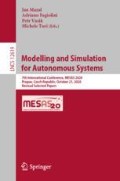Abstract
To assess the mission effectiveness and efficiency of future airborne systems-of-systems with autonomous components, appropriate performance models and metrics are required. In a first attempt, such metrics were derived systematically by subject-matter experts (SMEs) decomposing a specific mission and its tasks hierarchically, until measurable criteria were reached. Weights of the criteria were obtained through the Fuzzy Analytic Hierarchy Process (FAHP), using linguistic variables for the pairwise comparison of criteria on all decomposition levels.
This work demonstrates determination of such metrics in a multi-agent 2D simulation. The results are aggregated according to their respective weight, generating the mission run’s total evaluation.
An air-to-ground operation by multiple unmanned aerial vehicles (UAVs) with pop-up threats present was chosen as an example mission. Deploying different force packages, their UAV models having different characteristics, in the simulation yields distinct aggregated evaluation outcomes. These signify differences in efficiency and thus suitability for the selected mission.
For investigation of result robustness local sensitivity analysis is used. For validation it will be required to have the SMEs compare their assessments of the conducted missions to the generated results.
Access this chapter
Tax calculation will be finalised at checkout
Purchases are for personal use only
References
Grayson, T.: Mosaic Warfare, 27 July 2018. https://www.darpa.mil/attachments/STO-Mosaic-Distro-A.pdf. Accessed 6 August 2020
Jaiswal, N.K.: Military Operations Research. Quantitative Decision Making. International Series in Operations Research & Management Science, vol. 5. Kluwer Academic Publishers, Boston (1997)
Ernest, N.D.: Genetic fuzzy trees for intelligent control of unmanned combat aerial vehicles, University of Cincinnati (2015)
Stodola, P., Drozd, J., Mazal, J., Hodický, J., Procházka, D.: Cooperative unmanned aerial system reconnaissance in a complex urban environment and uneven terrain. Sensors (Basel, Switzerland) (2019). https://doi.org/10.3390/s19173754
Hodicky, J., Prochazka, D.: Modelling and simulation paradigms to support autonomous system operationalization. In: Mazal, J., Fagiolini, A., Vasik, P. (eds.) MESAS 2019. LNCS, vol. 11995, pp. 361–371. Springer, Cham (2020). https://doi.org/10.1007/978-3-030-43890-6_29
Morawietz, S., Strohal, M., Stütz, P.: A mission-based approach for the holistic evaluation of aerial platforms: implementation and proof of concept. In: 18th AIAA/ISSMO Multidisciplinary Analysis and Optimization Conference 2017, Denver, Colorado, USA, 5–9 June 2017: held at the AIAA Aviation Forum 2017. 18th AIAA/ISSMO Multidisciplinary Analysis and Optimization Conference, Denver, Colorado. Curran Associates Inc., Red Hook (2017). https://doi.org/10.2514/6.2017-4152
Morawietz, S., Strohal, M., Stütz, P.: A decision support system for the mission-based evaluation of aerial platforms: advancements and final validation results. In: 18th AIAA Aviation Technology, Integration, and Operations Conference 2018. Atlanta, Georgia, USA, 25–29 June 2018: held at the AIAA Aviation Forum 2018. 2018 Aviation Technology, Integration, and Operations Conference, Atlanta, Georgia. Curran Associates Inc., Red Hook (2018). https://doi.org/10.2514/6.2018-3975
Ruf, C., Zwick, M., Morawietz, S., Stütz, P.: Enhancing automated aerial reconnaissance onboard UAVs using sensor data processing-characteristics and pareto front optimization. In: AIAA Scitech 2019 Forum. AIAA Scitech 2019 Forum, San Diego, California. American Institute of Aeronautics and Astronautics, Reston, Virginia (2019). https://doi.org/10.2514/6.2019-1541
Habayeb, A.R.: Systems Effectiveness. Elsevier Science, Burlington (1987)
Seethaler, J., Strohal, M., Stütz, P.: Finding metrics for combat aircraft mission efficiency: an AHP-based approach. In: Deutscher Luft- und Raumfahrtkongress 2020 (in publication). Deutsche Gesellschaft für Luft- und Raumfahrt - Lilienthal-Oberth e.V., Bonn (2020). https://doi.org/10.25967/530013
vanGundy, A.B.: Brainwriting for new product ideas: an alternative to brainstorming. J. Consum. Market. 1, 67–74 (1983)
Saaty, R.W.: The analytic hierarchy process—what it is and how it is used. Math. Modelling (1987). https://doi.org/10.1016/0270-0255(87)90473-8
Mu, E., Pereyra-Rojas, M.: Practical Decision Making. An Introduction to the Analytic Hierarchy Process (AHP) Using Super Decisions v2. Springer, Cham (2017). https://doi.org/10.1007/978-3-319-33861-3
Buscher, U., Wels, A., Franke, R.: Kritische Analyse der Eignung des Fuzzy-AHP zur Lieferantenauswahl. In: Bogaschewsky, R., Eßig, M., Lasch, R., Stölzle, W. (eds.) Supply Management Research. Aktuelle Forschungsergebnisse 2010; [Tagungsband des wissenschaftlichen Symposiums Supply Management; Advanced studies in supply management, Bd. 3], vol. 140, 1st edn., pp. 27–60. Gabler, Wiesbaden (2010). https://doi.org/10.1007/978-3-8349-8847-8_2
Ossadnik, W., Schinke, S., Kaspar, R.H.: Group aggregation techniques for analytic hierarchy process and analytic network process: a comparative analysis. Group Decis. Negot. 25(2), 421–457 (2015). https://doi.org/10.1007/s10726-015-9448-4
Forman, E., Peniwati, K.: Aggregating individual judgments and priorities with the analytic hierarchy process. Eur. J. Oper. Res. (1998). https://doi.org/10.1016/S0377-2217(97)00244-0
Cho, Y.-G., Cho, K.-T.: A loss function approach to group preference aggregation in the AHP. Comput. Oper. Res. (2008). https://doi.org/10.1016/j.cor.2006.04.008
Schriver, A.T., Morrow, D.G., Wickens, C.D., Talleur, D.A.: Expertise differences in attentional strategies related to pilot decision making. Hum. Factors (2008). https://doi.org/10.1518/001872008X374974
Roth, R.T.: Quantifying Experience in the Value of Human Capital, ADA186585. US Air Force Academy, Colorado Springs (1987). https://apps.dtic.mil/sti/pdfs/ADA186585.pdf. Accessed 9 July 2020
Kelly, M.J.: Performance measurement during simulated air-to-air combat. Hum. Factors 30(4), 495–506 (1988)
Morawietz, S.: Konzipierung und Umsetzung eines Unterstützungssystems zur vergleichenden Bewertung von Luftfahrzeugen. Dissertation, Universität der Bundeswehr München (2018)
Geldermann, J., Lerche, N.: Leitfaden zur Anwendung von Methoden der multikriteriellen Entscheidungsunterstützung. Methode: PROMETHEE, Georg-August-Universität (2014). www.uni-goettingen.de/en/sh/57609.htmlde/document/download/285813337d59201d34806cfc48dae518.pdf/MCDA-Leitfaden-PROMETHEE.pdf. Accessed 24 Jan 2020
Hwang, C.-L., Yoon, K.: Multiple Attribute Decision Making. Methods and Applications: A State the Art Survey. Lecture Notes in Economics and Mathematical Systems, vol. 186. Springer, Berlin (1981). https://doi.org/10.1007/978-3-642-48318-9
The Mathworks Inc.: MATLAB. Version 2019b, Natick, Massachusetts (2019)
Zhu, X., Liu, Z., Yang, J.: Model of collaborative UAV swarm toward coordination and control mechanisms study. Procedia Comput. Sci. (2015). https://doi.org/10.1016/j.procs.2015.05.274
Colledanchise, M., Ögren, P.: Behavior Trees in Robotics and AI: An Introduction. Artificial Intelligence and Robotics Series 2018. Chapman & Hall/CRC (2017–2020)
Colledanchise, M., Faconti, D.: BehaviorTree.CPP (2014–2020). https://github.com/BehaviorTree/BehaviorTree.CPP. Accessed 2 Aug 2020
Author information
Authors and Affiliations
Corresponding author
Editor information
Editors and Affiliations
Rights and permissions
Copyright information
© 2021 Springer Nature Switzerland AG
About this paper
Cite this paper
Seethaler, J., Strohal, M., Stütz, P. (2021). Multi-UAV Mission Efficiency: First Results in an Agent-Based Simulation. In: Mazal, J., Fagiolini, A., Vasik, P., Turi, M. (eds) Modelling and Simulation for Autonomous Systems. MESAS 2020. Lecture Notes in Computer Science(), vol 12619. Springer, Cham. https://doi.org/10.1007/978-3-030-70740-8_11
Download citation
DOI: https://doi.org/10.1007/978-3-030-70740-8_11
Published:
Publisher Name: Springer, Cham
Print ISBN: 978-3-030-70739-2
Online ISBN: 978-3-030-70740-8
eBook Packages: Computer ScienceComputer Science (R0)

